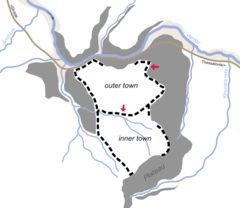Dobromir Chrysos

Dobromir, known to the Byzantines as Chrysos (Macedonian: Добромир Хрс, Bulgarian: Добромир Хриз, Greek: Δοβρομηρός Χρύσος), was a leader of the Vlachs[1] and Bulgarian Slavs[2] in eastern Macedonia during the reign of the Byzantine emperor Alexios III Angelos. According to Niketas Choniates, Dobromir Chrysos was, despite his Slavic name, a "Vlach" (an Aromanian or Megleno-Romanian) by birth.[3] However, most probably he was of mixed Slavic–Vlach origins.[4] Due to the complexity of pre-nationalist ethnic labels, references to modern ethnic groups in the Middle ages are obscure.[5][6] He became prominent in 1197 and is last heard of in 1202.
He was already married, but in order to cement an alliance with him the Emperor offered him a daughter of the Byzantine warlord Manuel Kamytzes. She was forced to divorce her husband and to marry Dobromir in 1198. About 1200 he took a third wife, the Emperor's granddaughter Theodora Angelina, who had previously been married to a rival leader, Ivanko.
In 1202 the lands of Dobromir Chrysos were conquered by Bulgarian emperor Kaloyan.
Sources[]
- O city of Byzantium: annals of Niketas Choniates tr. Harry J. Magoulias (Detroit: Wayne State University Press, 1984) pp. 267–270, 277-280, 293-294.
Notes[]
- ^ The meaning of the term "Vlach" in this period and region was the subject of fierce dispute in the late 19th and 20th centuries. For more see: Roumen Daskalov, Feud over the Middle Ages: Bulgarian-Romanian Historiographical Debates; in: Entangled Histories of the Balkans - Volume Three, Shared Pasts, Disputed Legacies, pp: 274–354. with Roumen Daskalov and Alexander Vezenkov as ed. BRILL, 2015; ISBN 9004290362.
- ^ John Van Antwerp Fine, (1994) The Late Medieval Balkans: A Critical Survey from the Late Twelfth Century to the Ottoman Conquest, University of Michigan Press, p. 29, ISBN 0472082604.
- ^ Paul Stephenson, Byzantium's Balkan Frontier: A Political Study of the Northern Balkans, 900-1204, Cambridge University Press, 29 iun. 2000, p.307
- ^ Bechev, D. Historical Dictionary of the Republic of Macedonia, Publisher: Scarecrow Press, 2009, ISBN 0810862956, introduction.
- ^ There are references in some Byzantine documents from that period to mixed people as "Bulgaro-Albano-Vlachs" or even to "Serbo-Albano-Bulgaro-Vlachs". For more see: John Van Antwerp Fine, The Late Medieval Balkans: A Critical Survey from the Late Twelfth Century to the Ottoman Conquest, University of Michigan Press, 1994, ISBN 0472082604, p. 355.
- ^ John V. A. (Jr.) Fine, When Ethnicity Did Not Matter in the Balkans: A Study of Identity in Pre-Nationalist Croatia, Dalmatia, and Slavonia in the Medieval and Early-Modern Periods, University of Michigan Press, 2010; ISBN 0472025600, p. 56.
Literature[]
- 12th-century Bulgarian people
- 13th-century Bulgarian people
- Bulgarian people of the Byzantine–Bulgarian Wars
- Medieval Bulgarian military personnel
- 12th-century births
- 13th-century deaths
- Medieval Bulgarian nobility
- History of the Aromanians
- Rulers in medieval Macedonia